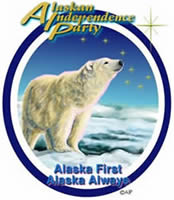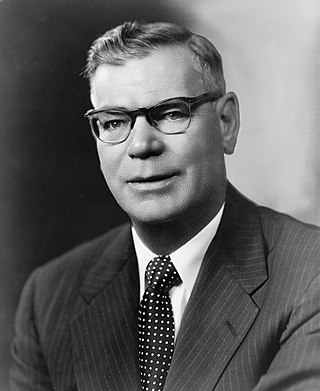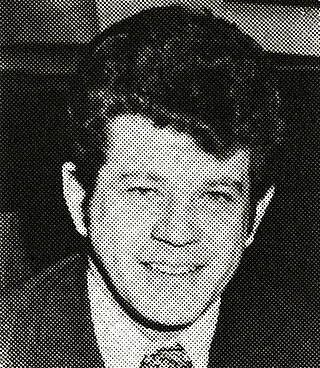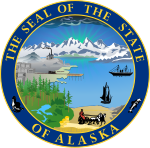
The Alaskan Independence Party (AIP) is an Alaskan nationalist political party in the United States that advocates for an in-state referendum which would include the option of Alaska becoming an independent country. The party also advocates positions similar to those of the Constitution Party, Republican Party and Libertarian Party, supporting gun rights, anti-abortion policies, privatization, homeschooling, and limited government.

Walter Joseph Hickel was an American businessman, real estate developer, and politician who served as the second governor of Alaska from 1966 to 1969 and 1990 to 1994, as well as U.S. Secretary of the Interior from 1969 to 1970. He worked as a construction worker and eventually became a construction company operator during Alaska's territorial days. Following World War II, Hickel became heavily involved with real estate development, building residential subdivisions, shopping centers and hotels. Hickel entered politics in the 1950s during Alaska's battle for statehood and remained politically active for the rest of his life.

Edward Lewis "Bob" Bartlett, was an American politician and a member of the Democratic Party. He served as a U.S. Senator. A key fighter for Alaska statehood, Bartlett served as the Secretary of Alaska Territory from 1939 to 1945, in Congress from 1945 to 1959 as a Delegate, and from 1959 until his death in 1968 as a U.S. senator. He was opposed to U.S. involvement in Vietnam, along with his fellow Senator Ernest Gruening, and also worked to warn people about the dangers of radiation. Many acts bear his name, including a major law known as the Bartlett Act, mandating handicap access in all federally-funded buildings.

Keith Harvey Miller was an American Republican politician from Alaska. Miller was the second secretary of state of Alaska under Walter Hickel. He became the third governor of Alaska after Hickel’s resignation to become U.S. Secretary of the Interior. Under his tenure, Alaska came into sudden wealth after an oil lease sale on the North Slope created a revenue of $900 million.

Leland Chancy Croft was a workers' compensation attorney and Democratic Party politician from the U.S. state of Alaska. Elected to the Alaska House of Representatives in 1968, he served a single term from 1969 to 1971. He was then elected to the Alaska Senate, serving in that body from 1971 to 1979, including serving as the president of the Senate from 1975 to 1977 during the 9th Alaska State Legislature.

On November 8, 1994, gubernatorial elections were held in 36 states and two territories across the United States. Many seats held by Democratic governors switched to the Republicans during the time known as the Republican Revolution. Notably, this marked the first time since 1969 that Republicans secured the majority of governorships in an election cycle.

The 1994 Alaska gubernatorial election took place on November 8, 1994, for the post of Governor of Alaska, United States. Democratic candidate Tony Knowles narrowly defeated Republican candidate Jim Campbell and Lieutenant Governor Jack Coghill of the Alaskan Independence Party. In the Republican Revolution year of the 1994 elections, Alaska's was the only governor's seat in the country to switch from Republican to Democratic.

The 1990 Alaska gubernatorial election took place on November 6, 1990, for the open seat of Governor of Alaska. In 1989, incumbent Governor Steve Cowper, a Democrat, had announced that he would not seek re-election for a second term.
The Fifth Alaska State Legislature served from January 23, 1967, to January 26, 1969.
Carl Eugene Moses was an American businessman from Unalaska, Alaska who served in the Alaska House of Representatives from 1965 to 1973 as both a Republican and Democrat, and was elected again to the House in 1992 running on the Alaskan Independence Party ticket, later switched back to the Democrats, and served until 2007. Moses served a total of eleven full terms in the Alaska House, making him the longest-serving member in the history of that body. In the 2006 primary election, Moses was defeated for renomination by Bryce Edgmon, losing via a coin toss after the election results wound up in court and were later certified by the state of Alaska as ending in a tie vote.

United States gubernatorial elections were held on 3 November 1970, in 35 states and two territories.

The 1986 Alaska gubernatorial election took place on November 4, 1986, for the post of Governor of Alaska. Incumbent Governor Bill Sheffield, a Democrat who was seeking re-election, was defeated by Steve Cowper in the Democratic primary election on August 26, 1986.

The 1968 United States Senate election in Alaska took place on November 5, 1968. Incumbent Democratic U.S. Senator Ernest Gruening ran for a second full term in office but finished behind Speaker of the Alaska House of Representatives Mike Gravel in the Democratic primary. Gruening launched a write-in bid for the seat in the general election, but finished third to Gravel and Republican former Anchorage mayor Elmer Rasmuson.

The 1970 United States Senate special election in Alaska was held on November 3, 1970, to fill a seat in the United States Senate following the December 1968 death of Democrat Bob Bartlett, who had been Alaska's senior Senator since statehood in 1959. Republican Ted Stevens was appointed to the seat temporarily on December 24, 1968, to serve until the election could be held.

The 1978 Alaska gubernatorial election took place on November 7, 1978, for the post of governor of Alaska. Republican incumbent Jay Hammond defeated four opponents: former Governor of Alaska and write-in candidate Wally Hickel, Alaska Senator and Democratic nominee Chancy Croft, former Commissioner of Natural Resources and Independent candidate Tom Kelly and Alaskan Independence Party nominee Don Wright. After losing to Hammond in the Republican primary, Hickel ran as a write-in candidate and was able to outperform Croft. Republican Tom Fink and Democrat Jay Kerttula also ran in the open primary.

The 1974 Alaska gubernatorial election took place on November 5, 1974, for the post of Governor of Alaska. Republican challenger and mayor of Bristol Bay Borough Jay Hammond narrowly beat Democratic incumbent Bill Egan in a close race that was forced into a recount to verify the results. The formation of the new Alaskan Independence Party was considered to have a large impact on the race. Hammond had defeated former governors Wally Hickel and Keith Harvey Miller for the Republican nomination, while Egan defeated Eben Hopson and Don Wright for the Democratic nomination.

The 1970 Alaska gubernatorial election took place on November 3, 1970, for the post of Governor of Alaska. Former governor and Democratic candidate Bill Egan was able to defeat incumbent Republican governor Keith H. Miller after having lost his position in the previous election to Wally Hickel. Miller had been appointed to fill the rest of Hickel's term after Hickel was nominated to be the U.S. Secretary of the Interior under President Richard Nixon. Miller defeated Representative Howard Wallace Pollock for the Republican nomination.

The 1962 Alaska gubernatorial election took place on November 6, 1962, for the post of Governor of Alaska. Incumbent Democratic governor William A. Egan was re-elected, defeating Republican challenger and former governor of Alaska Territory Mike Stepovich. In the primary elections, Egan defeated George Byer and Warren A. Taylor, while Stepovich defeated Howard Wallace Pollock and Jack Coghill.

The 1958 Alaska gubernatorial election took place on November 25, 1958, for the post of Governor of Alaska. It was Alaska's first gubernatorial election as a U.S. state, although this did not take effect until January 3, 1959. Democratic Shadow Senator William A. Egan and his running mate Hugh Wade defeated Republican State Senator John Butrovich and his running mate, former territorial tax commissioner K.F. Dewey.

Ermalee Hickel was an American public figure and philanthropist who served as the second and seventh First Lady of Alaska from 1966 to 1969 and again from 1990 to 1994. She was the wife of the former Governor of Alaska Wally Hickel and one of the last members of Alaska's generation of pioneer political families.




















